Introduction to Southern Cornbread
Cornbread is more than just a dish in the South—it’s a tradition steeped in history and flavor. Whether paired with a hearty stew or served warm with a pat of butter, this classic side dish holds a special place at the table. In this article, we’ll uncover the secrets to making the perfect southern cornbread recipe, covering everything from the ingredients to expert tips and variations. Let’s dive into the heart of this Southern staple!
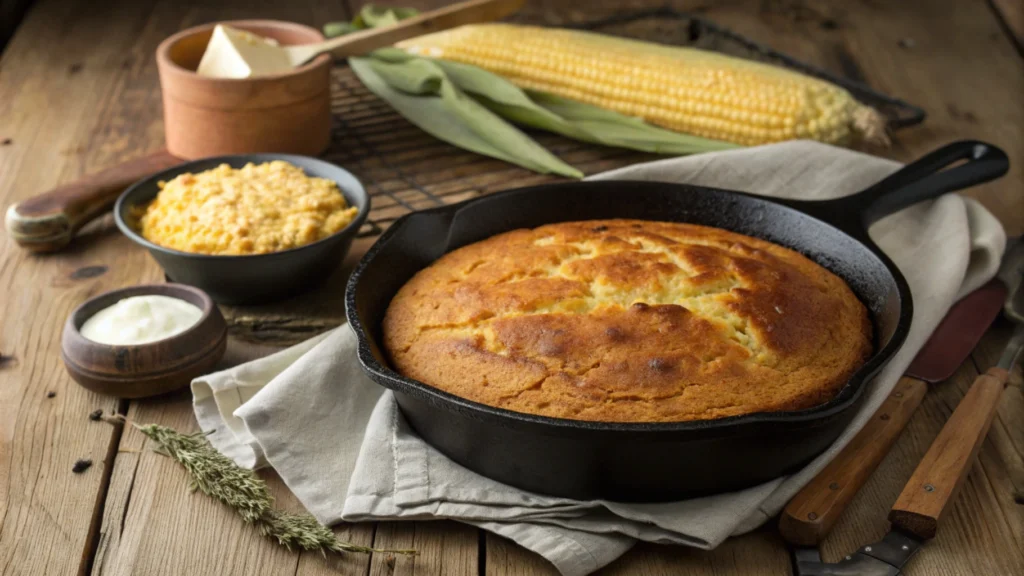
What is Southern Cornbread?
Southern cornbread is a simple yet flavorful dish made from cornmeal, a staple in Southern kitchens. Unlike its sweeter northern counterpart, Southern cornbread is traditionally savory, with a crisp crust and tender interior. It’s the perfect partner to soups, stews, and even fried chicken.
This version of cornbread is known for its distinctive texture and flavor, achieved through the use of ingredients like buttermilk and self-rising cornmeal. Cooked in a cast iron skillet, the result is a golden-brown crust that’s hard to resist.
Brief History and Origins
The origins of cornbread trace back to Native American cuisine, where ground corn was a vital food source. Southern cornbread evolved as settlers incorporated local ingredients and cooking techniques. Over time, it became a beloved dish across the South, with each family adding their unique twist to the recipe.
From farm kitchens to fine dining restaurants, cornbread remains a symbol of Southern hospitality and comfort food at its finest.
Why It’s a Staple in Southern Cuisine
Cornbread has earned its place as a staple due to its versatility, affordability, and ease of preparation. Whether it’s served alongside collard greens or crumbled into buttermilk, cornbread’s adaptability makes it a go-to side dish for countless Southern meals.
Plus, its crispy crust, rich flavor, and ability to soak up gravies and sauces make it irresistible. No wonder it’s a dish that has stood the test of time!
Ingredients for Authentic Southern Cornbread
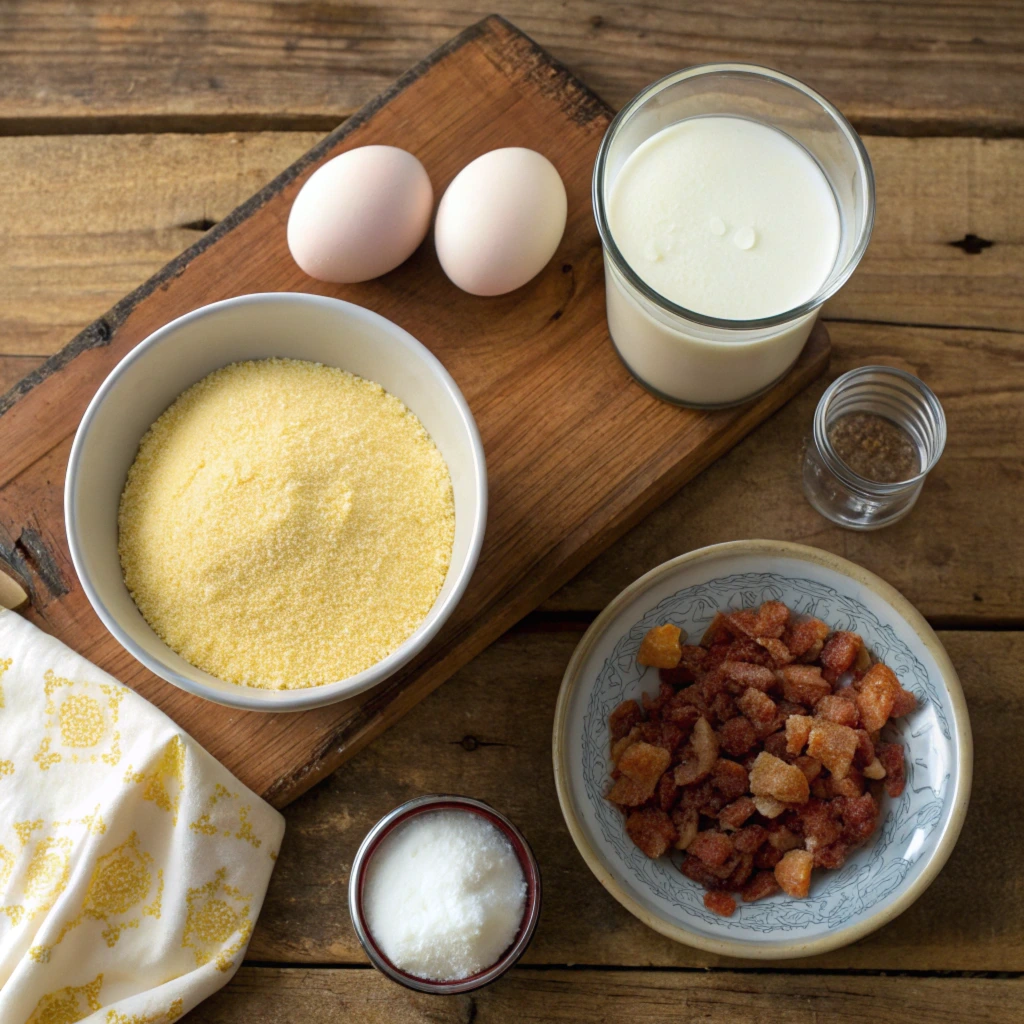
Essential Ingredients
To craft the perfect southern cornbread recipe, the ingredients you use make all the difference. Here’s what you’ll need:
- Cornmeal: The heart of the recipe! Choose self-rising cornmeal for convenience, or opt for regular cornmeal and mix in baking powder and salt for the same effect.
- Buttermilk vs. Milk: Buttermilk is a classic choice, lending a tangy flavor and tender crumb. If you’re out of buttermilk, regular milk works too—just add a splash of vinegar or lemon juice for a similar effect.
- Eggs: Eggs bind the batter and add richness. For a fluffier texture, beat them lightly before mixing.
- Fat Choices: Traditional Southern cooks swear by bacon grease or lard, which enhance the flavor. Vegetable oil or butter also work well for a slightly lighter option.
Optional Additions
While the classic recipe is delicious as is, a few optional tweaks can elevate your cornbread to new heights:
- Sugar Debate: Southern cornbread purists might skip the sugar, but a teaspoon or two can add balance without making it overly sweet.
- Savory Twists: Fold in diced jalapeños, shredded cheddar, or chopped green onions for a bold flavor punch.
- Sweet Variations: Add a touch of honey or molasses if you’re looking for a sweeter Northern-inspired version.
Understanding your ingredients is key to making cornbread that’s rich, flavorful, and authentically Southern. In the next section, we’ll dive into the tools and equipment you’ll need to nail that iconic crispy crust!
Tools and Equipment
The Cast Iron Skillet Advantage
No southern cornbread recipe is complete without the trusty cast iron skillet. This kitchen classic is the secret to achieving that golden, crispy crust that defines Southern cornbread. Cast iron retains and distributes heat evenly, ensuring your cornbread cooks perfectly from edge to center.
To prepare your skillet, heat it on the stovetop or in the oven with a generous amount of oil or bacon grease. Pouring the batter into a sizzling hot skillet creates an instant crust—a hallmark of authentic Southern cornbread.
Alternatives to Cast Iron: Baking Dishes and Pans
Don’t have a cast iron skillet? Don’t fret! A well-greased 8×8 baking dish or pie pan can work in a pinch. While it won’t deliver the same crusty edges, you’ll still end up with a deliciously tender cornbread. Just skip preheating the pan and grease it thoroughly before pouring in the batter.
Measuring Tools and Kitchen Essentials
Precision matters in baking, even for cornbread. Have these tools handy:
- Measuring cups and spoons for dry and wet ingredients.
- A whisk or fork for combining your batter.
- A heatproof spatula for transferring batter into the skillet or pan.
Armed with the right equipment, you’re one step closer to mastering this Southern staple. Up next: a detailed, step-by-step guide to preparing and baking your perfect cornbread!
Step-by-Step Recipe
Preheating the Skillet for the Perfect Crust
The key to a truly authentic southern cornbread recipe lies in the crust. Preheating your cast iron skillet is essential to achieving that golden, crispy exterior. Start by placing the skillet on the stovetop over medium-high heat or in an oven preheated to 400°F. Add a generous amount of bacon grease, vegetable oil, or lard—about ¼ cup—to the skillet. When the oil begins to shimmer or sizzle, you’ll know it’s ready for the batter. This step ensures your cornbread won’t stick while giving it that signature crust.
Mixing the Batter: Consistency Tips
While your skillet heats up, it’s time to mix the batter. In a large bowl, combine 2 cups of self-rising cornmeal, 1¾ cups of buttermilk (or regular milk with a splash of vinegar), 2 eggs, and 2 tablespoons of vegetable oil or melted butter. Whisk until the ingredients are well-blended but don’t overmix. Overmixing can result in a dense, tough cornbread. The batter should be slightly thicker than pancake batter—thick enough to pour easily but not too runny.
Pouring and Baking: Ensuring Even Cooking
Carefully remove the hot skillet from the heat and swirl the oil around to coat the bottom and sides evenly. Pour the batter into the sizzling skillet. The sound of the sizzle indicates that you’re on the right track. Place the skillet in the oven and bake for 25-30 minutes, or until the top turns golden brown and a toothpick inserted in the center comes out clean.
Serving Suggestions: Best Pairings for Cornbread
Once your cornbread is baked to perfection, let it cool slightly before slicing. For a true Southern experience, serve it warm alongside a bowl of hearty pinto beans or a comforting chicken pot pie. For a sweeter twist, slather it with butter and drizzle it with honey. Whether savory or sweet, Southern cornbread pairs beautifully with almost any meal.
For more delicious recipes, check out the collection on Makouri Recipes. Their detailed guides and ideas will inspire your next meal!
Southern Cornbread Variations
Traditional vs. Modern Takes
Southern cornbread has a cherished place in the hearts of many, but that doesn’t mean it can’t evolve! The traditional southern cornbread recipe is made with simple, savory ingredients like cornmeal, buttermilk, and eggs. However, modern twists often include creative add-ins and flavor enhancers to suit diverse tastes.
For a classic Southern feel, stick to the original recipe with a crispy, golden crust and no added sugar. If you’re experimenting with modern takes, consider incorporating ingredients like fresh herbs, cheddar cheese, or even diced jalapeños for a flavorful kick.
Sweet Cornbread: A Northern Twist
For those who enjoy a sweeter variation, consider adding a tablespoon or two of sugar, honey, or maple syrup to the batter. While it’s not traditional in Southern recipes, sweet cornbread is perfect for pairing with spicy dishes like chili or barbecue ribs. This version offers a delightful balance of flavors for those seeking a more dessert-like experience.
Gluten-Free or Vegan Options
Dietary restrictions don’t mean you have to miss out on delicious cornbread! For a gluten-free version, substitute the self-rising cornmeal with a gluten-free cornmeal mix. You can also use flaxseed meal as an egg replacement and almond or oat milk instead of buttermilk for a vegan-friendly option. Add a splash of apple cider vinegar to mimic the tangy flavor of buttermilk.
Cornbread’s versatility makes it a canvas for creativity. Whether you prefer the traditional approach or a modern adaptation, this dish can be customized to delight every palate. Up next, we’ll address common questions about Southern cornbread in the FAQ section!
FAQs About Southern Cornbread
What is the Difference Between Cornbread and Southern Cornbread?
The key distinction lies in the flavor and texture. Southern cornbread is savory, with a crispy crust and moist interior, often cooked in a preheated cast iron skillet. Northern cornbread, on the other hand, tends to be sweeter and softer, resembling a cake-like consistency. The difference reflects regional preferences and the ingredients used, such as sugar in Northern recipes and bacon grease or lard in Southern ones.
Why Do Southerners Avoid Sugar in Cornbread?
Traditionally, Southern cornbread is savory. Early Southern cooks relied on what was available, and sugar was often a luxury. Cornbread was a functional dish meant to complement the meal, not overpower it with sweetness. While some modern Southern recipes incorporate a touch of sugar, purists argue that the authentic southern cornbread recipe should remain sugar-free.
Is It Better to Use Milk or Buttermilk in Cornbread?
Buttermilk is the gold standard for Southern cornbread. Its tanginess adds depth of flavor and helps tenderize the cornmeal, resulting in a softer crumb. However, if you’re out of buttermilk, regular milk can be used as a substitute. For best results, add a tablespoon of vinegar or lemon juice to mimic buttermilk’s acidity.
What Do You Need for Dolly Parton’s Cornbread Recipe?
Dolly Parton’s iconic cornbread recipe sticks to Southern roots with ingredients like cornmeal, buttermilk, eggs, and a hint of sugar for balance. The use of bacon grease or lard in the skillet is a must for that crispy crust. Her recipe is often served with pinto beans, reinforcing its place as a comforting Southern dish.
By answering these common questions, you’ll not only deepen your appreciation for Southern cornbread but also feel confident in making your own. Coming up next, we’ll discuss the nutritional aspects and tips for making healthier versions of this beloved dish. Stay tuned!
Nutritional Insights
Calories and Macronutrient Breakdown
A typical serving of southern cornbread made with traditional ingredients provides around 200-250 calories. The macronutrient breakdown includes approximately:
- Carbohydrates: 30-35g (mostly from cornmeal)
- Protein: 5-7g (from eggs and buttermilk)
- Fats: 8-10g (from oil, lard, or bacon grease)
While cornbread is naturally low in sugar, sweetened variations or those served with honey or jam can increase the calorie count.
How to Make It Healthier Without Compromising Flavor
You don’t have to sacrifice flavor to enjoy a healthier version of cornbread. Here are some easy swaps and additions:
- Use Whole-Grain Cornmeal: Opt for stone-ground or whole-grain cornmeal to increase fiber content.
- Reduce the Fat: Replace some of the oil with unsweetened applesauce or Greek yogurt for fewer calories.
- Add Vegetables: Mix in finely chopped spinach, grated zucchini, or shredded carrots for added vitamins.
- Try Plant-Based Milks: Unsweetened almond or oat milk can be a great substitute for buttermilk, especially for vegan versions.
By tweaking the recipe slightly, you can create a dish that’s both nourishing and delicious, suitable for everyday meals or special occasions.
Next, we’ll cover troubleshooting and expert tips to perfect your southern cornbread recipe!
Troubleshooting and Expert Tips
Common Issues and How to Fix Them
Even seasoned cooks occasionally encounter hiccups with their southern cornbread recipe. Here are some common problems and simple solutions:
- Dry or Crumbly Texture:
- Cause: Overbaking or using too little fat.
- Fix: Check your cornbread a few minutes before the recommended baking time and ensure the batter contains enough oil or buttermilk.
- Dense Cornbread:
- Cause: Overmixing the batter or using outdated leavening agents.
- Fix: Mix the batter gently and ensure your baking powder or self-rising cornmeal is fresh.
- Uneven Cooking:
- Cause: Skillet wasn’t preheated or batter wasn’t spread evenly.
- Fix: Always preheat your skillet and level out the batter before baking.
Secrets to a Crispy Golden Crust
The crust is the crowning glory of Southern cornbread. To achieve it:
- Preheat Your Skillet: A hot skillet creates instant crust when the batter hits the pan.
- Use Enough Oil: Swirl ¼ cup of bacon grease or vegetable oil in the skillet for optimal crispiness.
- Flip for Extra Texture: After baking, flip the cornbread out of the skillet and return it crust-side up for a polished presentation.
Avoiding Overmixing for the Right Texture
Overmixing is a common mistake that leads to dense, heavy cornbread. To avoid this:
- Combine ingredients just until mixed; it’s okay if the batter is slightly lumpy.
- Use a wooden spoon or spatula instead of a whisk to control mixing.
Follow these expert tips to perfect your cornbread every time! Next, we’ll highlight related recipes and pairings to complement your dish. Stay tuned!
Related Recipes and Pairings
Pinto Beans and Cornbread: A Classic Duo
Nothing says Southern comfort like a warm bowl of pinto beans paired with a slice of southern cornbread. The creamy beans and savory cornbread balance each other perfectly, creating a hearty, satisfying meal. Add a touch of hot sauce or a side of collard greens to elevate this timeless pairing.
Cornbread with Chicken Pot Pie
Cornbread is a fantastic companion to chicken pot pie. Its crumbly, buttery texture contrasts beautifully with the creamy filling of the pot pie. Serve a square of cornbread on the side or use it as a topping for an extra-special twist.
Cornbread with Butter and Jam
For a simple yet indulgent treat, serve cornbread warm with a dollop of butter and a smear of jam. This sweet-and-savory combination works well as a breakfast option or a mid-afternoon snack. Honey butter or fruit preserves add a touch of decadence.
For more comforting recipes and creative pairing ideas, explore Makouri Recipes for inspiration. Their collection includes classic dishes and modern takes that pair wonderfully with cornbread.
Conclusion
Southern cornbread is more than just a dish—it’s a symbol of comfort, tradition, and togetherness. From its crispy golden crust to its tender interior, every bite carries the rich heritage of Southern cuisine. Whether paired with pinto beans, served alongside a chicken pot pie, or enjoyed simply with butter and jam, this timeless staple is as versatile as it is delicious.
By following this southern cornbread recipe, you’re not just baking—you’re preserving a legacy that has brought families together for generations. Whether you stick to the classic savory version or experiment with modern twists, the joy of making cornbread lies in its simplicity and adaptability.
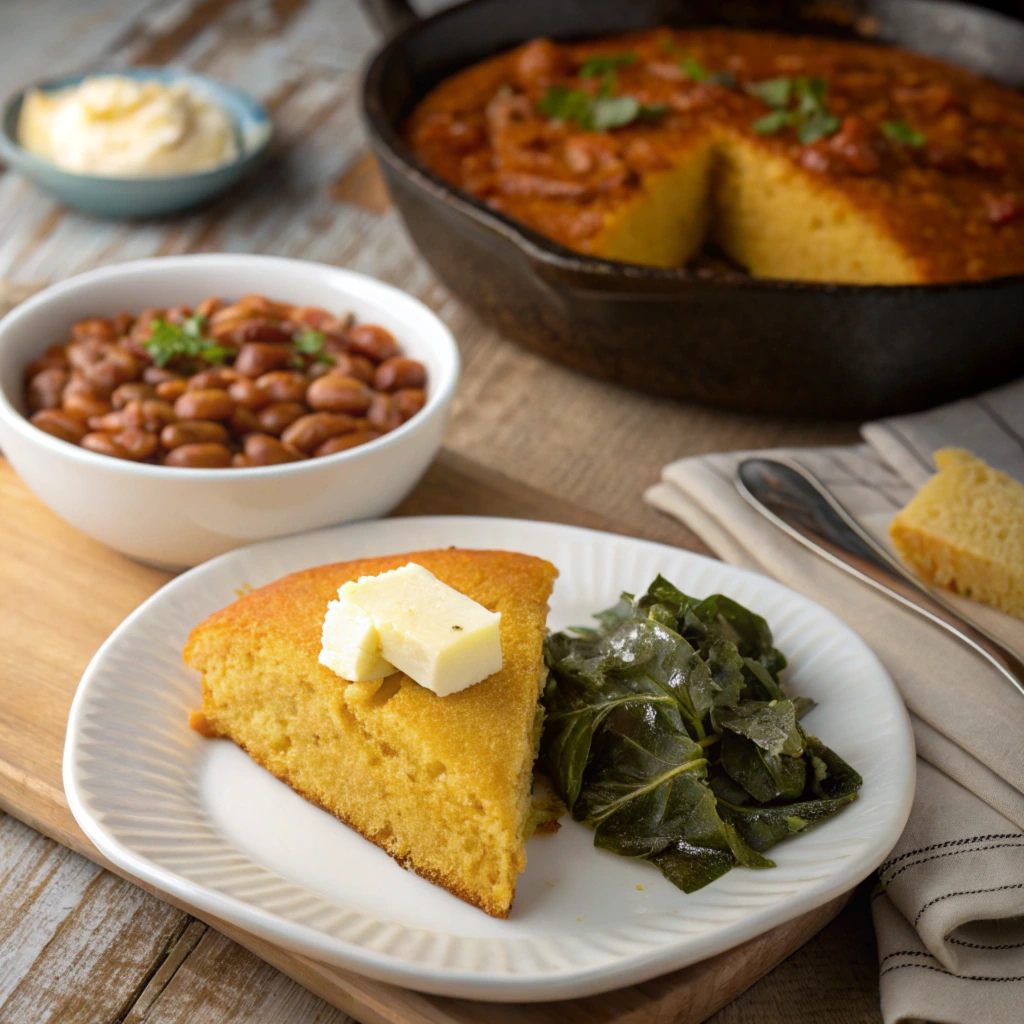
So, grab your cast iron skillet, preheat your oven, and experience the magic of Southern cornbread. And remember, it’s not just about the food—it’s about the love and memories you create around the table. Happy baking.

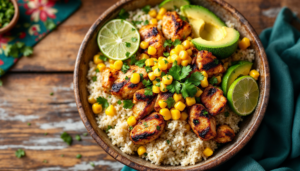

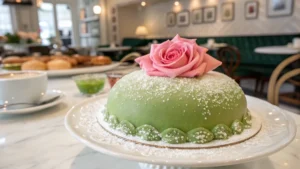
6 thoughts on “Southern Cornbread Recipe: A Timeless Delight”